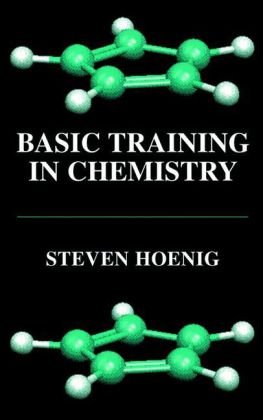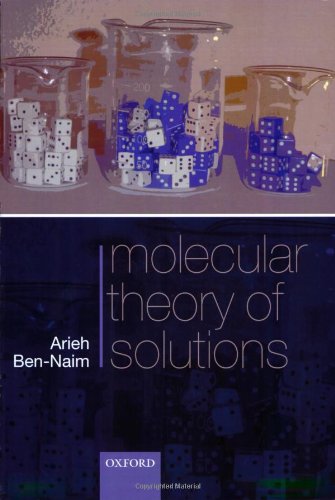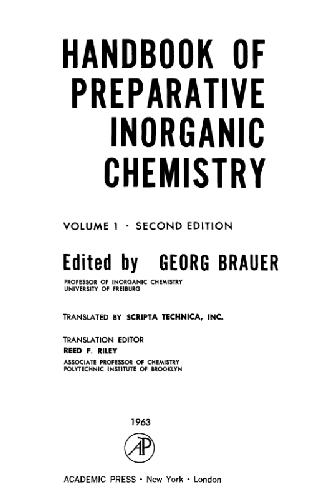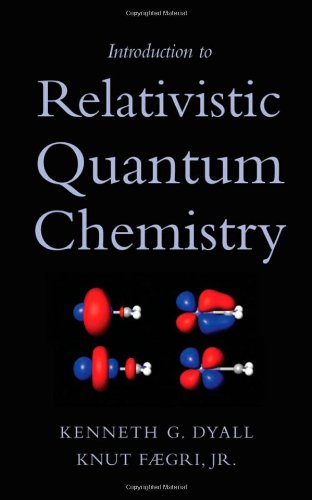Ian W. M. Smith, Ian W. M. Smith9781848162099, 184816209X
This book brings together, for the first time, the results of recent research in areas ranging from the chemistry of cold interstellar clouds (10 20 K), through laboratory studies of the spectroscopy and kinetics of ions, radicals and molecules, to studies of molecules in liquid helium droplets, to attempts to create molecular (as distinct from atomic) Bose Einstein condensates.
The chapters fall into two parts, the first one dealing with low-temperature experiments and environments (ca. 1 20 K). In the context of this book, these chapters can be said to deal with relatively mature fields. The second part deals with very low temperatures and very cold molecules. Here, more emphasis is placed on the methods employed to generate samples of molecules at extremely low (
Table of contents :
Contents……Page 10
Preface……Page 6
Contents……Page 12
1.1 Introduction……Page 13
1.1.1 InterstellarMolecules and Their Chemistry……Page 15
1.2 Gas-Phase Chemical Processes……Page 19
1.2.1 Ion-molecule and Dissociative Recombination Reactions……Page 20
1.2.2 Neutral-Neutral Reactions……Page 23
1.2.3 Radiative Association……Page 24
1.2.4 Organic Chemistry……Page 27
1.2.5 Negative Ion Formation……Page 30
1.3.1 Low-Temperature Surface Chemistry……Page 33
1.3.2 H2 Formation……Page 34
1.3.3 Reactions in IceMantles……Page 35
1.4.1 Time Scales……Page 36
1.4.2 Homogeneous Sources……Page 37
1.4.3 Non-Homogeneous Sources……Page 43
1.5 Deuterium Fractionation……Page 46
1.6.1 Rate Equations……Page 53
1.6.2 Stochastic Approaches……Page 56
1.6.3 Gas-GrainModels of Cold Cores……Page 58
Acknowledgement……Page 60
References……Page 61
Contents……Page 66
2.1 Introduction……Page 67
2.2.1.1 Nature of the Measurements: Rate Coefficients and Branching Ratios or Cross Sections……Page 71
2.2.1.2 Nature of the Reagent: Neutral or Charged Species……Page 72
2.2.1.3 Nature of the Cooling: Cryogenic Cooling or Supersonic Expansion……Page 73
2.2.2.1 Ion-Molecule Reactions……Page 74
2.2.2.2 Electron Attachment……Page 76
2.2.2.3 Neutral-Neutral Reactions……Page 77
2.3.1 General Aspects and Limitations of the Technique……Page 79
2.3.2 Reaction Kinetics Involving Charged Species……Page 82
2.3.3 Radical-Neutral Reactions……Page 83
2.3.4 The Pulsed Version of the CRESU Technique……Page 86
2.4.1 Fast Binary Reactions of Ions withMolecules……Page 89
2.4.2 Fast Reactions of Ions with Non-PolarMolecules……Page 90
2.4.3 Fast Reactions of Ions with PolarMolecules……Page 91
2.4.5 Association Reactions……Page 92
2.4.6 Electron-Molecule Reactions: The Thermalisation Problem……Page 93
2.5.1 Overview of Neutral-Neutral Reaction Studies……Page 97
2.5.2 The Radical-Radical Reaction O + OH: An Experimental (and Theoretical) Challenge……Page 105
2.5.3 Another Challenge: Large Molecules, the Case of PAHs……Page 109
2.5.4 Rationalising Low Temperature Reactivity for Radical — Molecule Reactions: A Case Study of the Reactions of O(3P) with Alkenes……Page 113
2.5.5 The Onset of Condensation: Dimer Formation in the CRESU Experiment……Page 118
2.6.2 Simple Radical-Neutral Reactions Including Radical-Radical Processes……Page 121
2.6.4 Product Detection……Page 122
2.6.5 Pulsed Laval Nozzles: Toward Absolute Zero?……Page 123
References……Page 125
Contents……Page 132
3.1.2. Ultracold Collisions and Quantum Matter……Page 133
3.1.3. De.nition of “Temperature”, Coherent Motion……Page 134
3.1.5. Reactions at Low Temperatures……Page 135
3.2.1. Inhomogeneous Electric Fields……Page 136
3.2.2. Multipole Fields……Page 137
3.2.3. Selecting Parameters……Page 138
3.2.4. Some Features……Page 139
3.2.5. Cooling Ions……Page 140
3.3. Kinematics……Page 143
3.3.1. Beam-Beam Arrangements……Page 144
3.3.2. Collision Energy……Page 145
3.3.3. Energy Resolution……Page 146
3.3.4. Slow Beam — Thermal Target……Page 147
3.4.1. Guided Ion Beam Merged with a Neutral Beam……Page 149
3.4.2. RF Ion Traps, Bu.er Gas Cooling……Page 155
3.4.3. How to Determine Temperatures……Page 160
3.4.4. Sub-Kelvin Cooling of Trapped Ions……Page 163
3.4.5. Collisions in a Sympathetically Cooled Ion Crystal……Page 164
3.5.1. The Role of Fine-Structure, Rotational, and Zero Point Energy……Page 166
3.5.2. Reactions with Signi.cant Temperature Dependences……Page 171
3.5.3. Formation and Destruction of Hydrocarbons……Page 173
3.5.4. Pure Hydrogen Chemistry……Page 176
3.5.5. State Speci.c Reactions……Page 179
3.6. Conclusions and Outlook……Page 180
References……Page 181
Contents……Page 186
4.1. Introduction……Page 187
4.2. Capture Rates for Long-Range Potentials……Page 189
4.2.1. Statistical Theories for Isotropic Potentials……Page 190
4.2.2. Statistical Theories for Anisotropic Potentials……Page 192
4.2.4. Adiabatic Channel Calculations and Quantum Dynamics……Page 198
4.2.5. Illustrative Comparisons……Page 202
4.3.1.1. Inner Transition State……Page 206
4.3.1.2. Outer Transition State……Page 208
4.3.2. Radical-Radical Systems……Page 209
4.4. Short-Range Interactions and the Two Transition State Model……Page 210
4.4.1. Radical-Molecule Reactions……Page 213
4.4.2. Ion-Molecule Reactions……Page 221
4.4.3. Radical-Radical Reactions……Page 223
4.5. Summary……Page 229
References……Page 230
Contents……Page 242
5.1. Introduction……Page 243
5.2. Weakly Bound Molecules: Moving Beyond the Harmonic Oscillator……Page 245
5.3. Van der Waals Clusters……Page 248
5.4. “Squeezing” the Spectra, One Atom at a Time: Solvation and Many-Body Terms……Page 251
5.5. “Plucking” a Hydrogen Bond: Vibrational Dynamics on the Simplest Hydrogen Bonded Interaction Potential……Page 260
5.6. Quantum Mechanical Tunneling……Page 262
5.7. Vibrational Predissociation: Energy Flow and Hydrogen Bond Rupture within the Simplest of Hydrogen Bonds……Page 265
5.8. Intermolecular Energies: A Critical Test of the (HF)2 Hydrogen Bond Potential Energy Surface……Page 269
5.9. Slit Discharge Methods: Spectroscopy of Jet Cooled Hydrocarbon Radicals……Page 272
5.10. Methyl and Halogenated Methyl Radicals……Page 276
5.11. Ethyl Radical: Internal Rotation and Hyperconjugation……Page 282
5.12. Allyl and Cyclopropyl Radicals: Ring Opening, Tunneling and IVR……Page 285
5.13. Vinyl Radical: Tunneling and H-Atom “Roaming”……Page 290
5.14. Jet-Cooled Molecular Ions: Breakdown of the Born-Oppenheimer Approximation in H2D+/D2H+……Page 292
5.15. Protonated Water: Isotopically Mediated Tunneling Dynamics in Hydronium Ion……Page 295
5.16. Looking Toward the Future……Page 299
References……Page 300
6.1.1. Cold Molecules……Page 306
6.1.2. Interaction with Radiation……Page 309
6.1.3. Cooling Complex Systems……Page 310
6.1.4. Preview……Page 311
6.2.1. Trapping, Probing, and Detecting……Page 312
6.2.2. Laser Based Detection and Cooling……Page 314
6.2.3. Sympathetic Cooling in Traps……Page 318
6.2.4. Buffer Gas Cooling……Page 321
6.2.5. Heating of Stored Ions……Page 324
6.2.6. Specific Instruments……Page 327
6.3.1. Fine Structure Relaxation in Atomic Ions……Page 331
6.3.2. Rotation of Diatomic Molecules……Page 335
6.3.3. Preparing Ultracold H+ 3……Page 340
6.3.4. Electronic Spectra of Ions of Astrophysical Interest……Page 343
6.3.5. Spectroscopy of Cold Biological Molecules……Page 345
6.4. Conclusions……Page 348
References……Page 350
Contents……Page 356
7.1. Introduction……Page 357
7.2.1. Droplet Formation and Droplet Sizes……Page 361
7.2.2. Doping Droplets……Page 364
7.2.3. Self-Organisation of Embedded Clusters……Page 365
7.3.1. Translational Degrees of Freedom……Page 366
7.3.2. Rotational Degrees of Freedom……Page 367
7.3.3. Vibronic Degrees of Freedom……Page 369
7.4. Photochemistry in Helium Droplets……Page 374
7.4.1.1. Photodissociation of H2O……Page 375
7.4.1.2. Photodissociation of NO2……Page 377
7.4.1.3. Photodissociation of CF3I and CH3I……Page 378
7.4.2.1. Photoionization in pure helium droplets……Page 381
7.4.2.2. Photoionization of Ag8 Clusters in Helium Droplets……Page 383
7.4.2.3. Photoionization of Aniline in Helium Droplets……Page 384
7.4.3. Photo-Induced Tautomerization in 3-Hydroxyflavone……Page 385
7.5.1. Ion-Molecule Reactions……Page 388
7.5.2. Spectroscopy of Entrance and Exit Channel Complexes……Page 391
7.5.3. Photon-Induced Isomerization……Page 392
7.5.4. Neutral Molecule Reactions……Page 394
7.6. Summary and Outlook……Page 398
References……Page 400
8.1. Introduction……Page 404
8.1.1. Cold and Ultracold Molecules for Chemical Dynamics……Page 405
8.2. Kinematic Cooling Molecules……Page 408
8.2.1. Cooling in Kinematic Cooling……Page 414
8.3.1. Crossed Atomic and Molecular Beams……Page 417
8.3.2. Velocity Mapped Ion Imaging……Page 420
8.3.3. Production of Cold Nitric Oxide……Page 422
8.3.4. Production of Cold NH3 and HBr……Page 425
8.3.5. Techniques for Trapping Kinematically Cooled Molecules……Page 428
8.3.5.1. Magnetic Trapping……Page 429
8.3.5.2. Electrostatic Trapping……Page 431
8.3.6. Slow Molecule Source……Page 432
8.4. Kinematic Cooling of Molecules by Collision in a MOT……Page 434
8.5. Conclusion……Page 438
References……Page 439
Contents……Page 444
9.1. Introduction……Page 445
9.2.1. The Stark Decelerator……Page 452
9.2.2. Phase Stability in the Stark Decelerator……Page 455
9.2.3. Transverse Focusing in the Stark Decelerator……Page 458
9.2.4. Stark Deceleration of OH Radicals……Page 459
9.2.5. Longitudinal Focusing of a Stark Decelerated Molecular Beam……Page 462
9.2.6. Decelerating Molecules in High-Field Seeking States……Page 464
9.2.7. Other Types of Decelerators……Page 466
9.3.1. DC Trapping of Molecules in Low-Field Seeking States……Page 467
9.3.2. The Storage Ring and the Molecular Synchrotron……Page 469
9.3.3. AC Trapping of Molecules in High-Field Seeking States……Page 472
9.3.4. Trap Lifetime Limitations……Page 475
9.4.1. High Resolution Spectroscopy and Metrology……Page 476
9.4.2. Collision Studies at a Tunable Collision Energy……Page 479
9.4.3. Direct Lifetime Measurements of Metastable States……Page 481
9.5. Conclusions and Outlook……Page 482
References……Page 487
10.1. Introduction……Page 492
10.2. Recent History: The Scope of the Problem……Page 493
10.3.1. Basic Concepts of Scattering Theory……Page 499
10.3.2. Quantum Collisions as Energy Approaches Zero……Page 506
10.3.3. Relations between Phase Shift, Scattering Length, and Bound States……Page 511
10.3.4. Scattering Length in a Square-well Potential……Page 515
10.3.5. Collisions in a Light Field……Page 519
10.4. Photoassociation at Ambient and Cold Temperatures……Page 522
10.5. Associative and Photoassociative Ionization……Page 525
10.6. Photoassociative Ionization in Atom Beams……Page 531
10.7. Ground State Collisions……Page 536
10.8. Early work……Page 537
10.9. Bose-Einstein Condensation……Page 539
10.9.1. Designer Condensates……Page 547
10.10. Quantum-Information Collisions……Page 551
10.11.1. Cold Molecules From Ultracold Gases……Page 553
10.11.2. Cold Molecules, Photoassociation and Coherent Control……Page 555
References……Page 559
Index……Page 572







Reviews
There are no reviews yet.